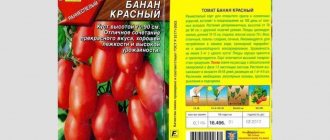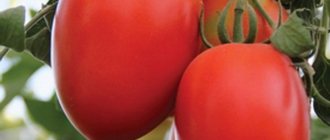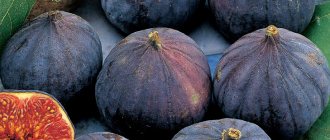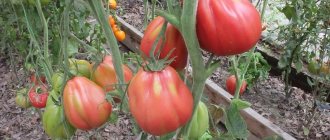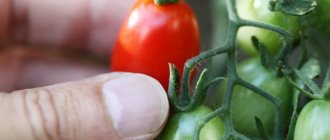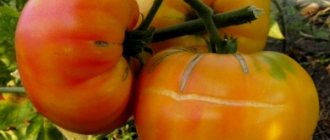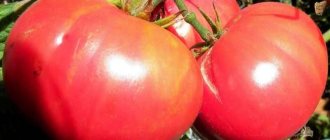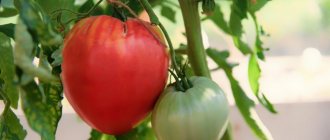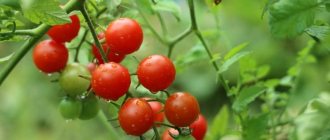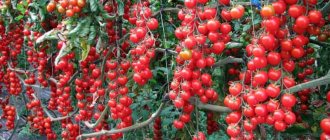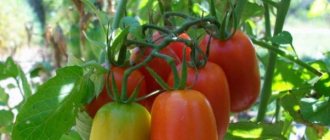» Vegetable growing » Tomatoes » Characteristics and features of growing red fig tomato
0
1054
Article rating
The Red Fig tomato got its name due to its appearance, reminiscent of an oriental fruit with a sweet and cloying taste. Fruits with a honey aroma and delicate pulp are in demand and are of great value in cooking and canning.
- Advantages and disadvantages
- Germination of seedlings
- Seed preparation
- Substrate and container
- Sowing technique
- Picking
- Transplanting to a garden bed
- Subtleties of care
- Conclusion
Characteristics and features of growing tomatoes Red figs
Growing tomatoes
The seedlings are transplanted to a permanent location after the soil has warmed up. In most regions this occurs in the second half of May or early June.
Planting tomatoes in a permanent place
First of all, you need to choose a suitable location for your tomato beds. It should be well lit and protected from the winds. You cannot use areas of the garden where nightshade crops have grown over the past three years.
They have been preparing the area for tomatoes since the fall. The beds are dug up and freed from plant debris. Organic fertilizers are added to the soil, for example, chicken droppings, mullein, potato peelings.
Be sure to check the acidity of the soil using litmus paper. If the indicators are elevated, alkali is added to the soil.
In the spring, before digging, mineral fertilizers, including phosphorus and potassium, are scattered over the beds. Then the beds are dug up and cleared of weed roots.
The holes are dug in rows, the distance between them is at least 60 cm. A gap of 50-60 cm is maintained between the holes. Per 1 sq. m there should be no more than 3-4 plants.
A tablespoon of stove ash is poured into each hole. The plants are removed from the pot and, together with a lump of earth, placed in a recess. Then the holes are covered with earth and watered with warm water.
Tomato care
Pink fig tomato bushes are formed into 1 or 2 stems. In the first case, the fruits will be larger and they will ripen faster, and in the second there will be more of them. In the afternoon, remove all excess shoots and yellowed leaves from the bottom of the stem.
Water the tomatoes as the soil dries out. Watering should be plentiful, but not frequent.
Pink figs are picky about soil composition. The plants are fed four times per season. Foliar fertilizing is also applied.
Mineral fertilizers alternate with organic ones. Purchased complex formulations are often used. Some gardeners prefer to prepare natural fertilizers themselves.
Fertilizer recipes:
- Organic mix. For 5 liters of water, take a glass of mullein and chicken droppings. The composition is thoroughly mixed and allowed to brew for 24 hours.
- Compost. To prepare it, pour a full bucket of fresh grass (without compacting it), add half a glass of ash and lime and 1 tbsp. l. carbonic acid dimide. The mixture is poured with water and allowed to brew for two days.
- Enriched herbal tincture. Finely chop the grass into a bucket and fill it with water. The mixture is allowed to ferment for 14 days, after which it is filtered and diluted with water in a ratio of 2/1. Add a glass of ash and mullein to the resulting composition.
- Fertilizer made from coffee grounds. The used coffee grounds are dried and placed under the roots of the plants. After this, they are watered with warm water.
- Yeast fertilizer. 2 packs of “live” yeast are poured into 5 liters of water. Add 4 tbsp to the composition. l sugar. When the mixture begins to rise, add another 2 liters of warm water.
Foliar feeding is applied every two weeks. Tomatoes are sprayed with the following compounds:
- add 1 tsp of urea to 10 liters of water;
- Add 1 teaspoon of urea, boric acid and copper sulfate to 10 liters of water.
What features do pink tomatoes and red figs have?
Pink Fig tomato will certainly appeal to those gardeners who prefer to grow sweet and fleshy tomatoes on their plot. This variety received its original name due to its external resemblance to the southern fruit and rich honey taste without any sourness.
History of the appearance of the variety
The Pink Fig variety appeared thanks to the work of Russian breeders. It has been listed in the State Register of the Russian Federation since 2012. The originator was the domestic one.
The variety was specially bred for cultivation throughout the Russian Federation. In the southern regions of the country, the Fig tomato can be planted in open ground. In the Middle Zone and the North, this variety is recommended to be grown only in a greenhouse.
Note! The Fig variety is not only pink-fruited; there is also a variety with red and yellow fruits. The yellow fig has especially tender and aromatic pulp.
Yellow Fig Information
Determinate plant. The bushes grow no more than 1 meter in height. The color of the fruit is yellow. The weight of one tomato is 200-250 g.
The ribbing of the yellow Fig is weakly expressed compared to the pink and red varieties. The pulp is sweet, without pronounced acidity, very tender and sugary.
With proper agricultural technology, from 1 sq. m you can collect 7-9 kg of ripe tomatoes.
About red figs
The Red Fig tomato is an indeterminate variety. The bushes grow up to 2-2.5 m in height.
The fruits have pronounced ribbing, which makes them very similar to the fig fruit.
The weight of one tomato is 300-350 g. The pulp is sugary and soft. The taste is sweet, practically without sourness. If you follow the norms and rules of planting, then from 1 sq. m you can collect up to 12 kg of tomatoes.
Characteristics, description of the variety
Pink tomato Fig is an indeterminate plant. The height can reach from 1.5 m to 3 m. The bushes grow spreading, the amount of green mass is moderate.
Ripening period is mid-early. The first ripe tomatoes can be harvested at the beginning of July. Fruiting lasts until the end of September. 3-6 tomatoes are tied on one fruit cluster.
Ripe tomatoes are pear-shaped with pronounced ribbing. Color - raspberry pink. The weight of tomatoes is 200-600 g. But with intensive feeding it can reach 900 g.
The taste is pleasant, sweet, without pronounced acidity. The pulp is tender and fleshy, in large-fruited tomatoes with voids.
The yield of pink figs when grown in a vegetable garden is 4-5 kg of fruits per bush. If tomatoes are planted in greenhouses, the yield will increase to 6-7 kg.
Important! To increase productivity, you need to remove all leaves and stepsons that grow below the first fruit cluster. It is better to do this before flowering begins.
Tomato variety Pink Fig is quite tasty when fresh. This variety is also suitable for freezing, whole-fruit canning, and processing into ketchup and juice.
Advantages and disadvantages of the variety
Benefits of Fig tomato:
- good taste of fruits, in which sugar content predominates;
- original appearance;
- good immunity to viruses and fungi;
- the ability to bear fruit throughout the growing season, right up to the coldest weather;
- ease of care;
- seed germination almost 95%;
- good transportability;
- excellent productivity;
- the fruits are versatile in use.
But, despite so many positive qualities, the Fig variety also has disadvantages:
- ripe fruits have small voids;
- not very high frost resistance;
- the fruits are very large and because of this the branches often break;
- needs frequent feeding;
- it is necessary to mold the bushes.
It is easy to see that the disadvantages most likely relate to the difficulties of growing. A good owner will not have any problems with this tomato.
Agrotechnics of cultivation
To get a bountiful harvest of tasty tomatoes, it is important to follow agricultural practices.
Seedling
To obtain seedlings, tomato seeds need to be planted in prepared soil. It is better to do this in mid-February or early March.
Planting material should be deepened into the ground by 1-1.5 cm. The distance between the seeds should be about 2 cm. Moisten the plantings with a spray bottle, cover with film and place in a warm (+22 ° C) and dark place.
When the first shoots appear, move the containers to a bright place and remove the film. Water carefully, as needed, when the top layer of soil dries out.
When two or three true leaves appear, pick the plants into separate cups. Plant in a greenhouse or garden bed two months after germination.
Watering
The pink variety of tomatoes Inzhip loves frequent watering. The bushes need to be watered 3-4 times a week, 2.5-3 liters of warm and settled water per plant.
Important! Watering should be carried out strictly at the root, in the morning or evening.
After moistening the soil, in order to avoid the formation of rot on the stems and fruits, you need to ventilate the greenhouse well. Dried soil should be loosened, this will help enrich the roots with oxygen.
It is also important to remove weeds and mulch the soil under the bushes between the rows.
30 days before the end of the growing season, you should pinch the top of the bush. As it grows, you need to tie up all the shoots and large brushes.
Note! Tomatoes should not lie on the ground, otherwise they will begin to rot.
Top dressing
Tomatoes need fertilizing with potassium and phosphorus. You can also use liquid manure or chicken manure.
Fertilizing should be done once every 3-4 weeks, alternating mineral complexes with organic matter.
To improve the taste and speed of ripening, tomatoes need to be fertilized with the following solution:
- 2 tbsp. spoons of superphosphate;
- 1 tbsp. a spoonful of liquid sodium humate;
- 10 liters of water.
You will need to pour 1 liter of prepared liquid under each bush.
To increase the yield, tomato bushes can be watered with a stimulating agent, which is simply prepared from the following ingredients:
- 1 cup sifted wood ash;
- 10 g boric acid;
- 10 liters of water.
Pest and disease control
The Fig tomato variety is characterized by increased resistance to many diseases.
But tomatoes that are planted in greenhouses need preventive spraying against fungal diseases. For treatment, you can use any biological product that can be found in a garden store.
It is better to use insecticides to control pests.
Harvesting pink fig tomatoes
The first ripe fruits of the Pink Fig can be harvested in early July.
At the end of August-beginning of September, upon the arrival of late blight, it is better to immediately collect all the tomatoes (including green ones). Fig tomatoes can be ripened indoors at room temperature without losing their taste.
If you violate important rules of agricultural planting and care, this will lead to bad consequences and great disappointment. It is very important to follow all the recommendations, then the pink Fig tomato will reward you with a generous harvest.
Germination of seedlings
For good productivity and obtaining tasty fruits, the seedling method of growing the crop is used.
The optimal sowing time is the end of March or the beginning of April. Before planting in the garden, in the last ten days of May or early June, the seedlings will get stronger, reach a good height (30 cm) and foliage (4-6 leaves).
Seed preparation
Characteristics of the Red Fig variety include high disease resistance, but to increase the percentage of germination and immunity of future crops, the seeds need to be treated:
- first they are soaked in a raspberry solution of potassium permanganate for half an hour, then washed with clean water;
- then immersed in a stimulant solution (Epin or Zircon) for an hour.
After processing, the seeds are washed with water and wrapped in a damp cloth, placed in the refrigerator for a day.
Tatyana Orlova (Vasilidchenko) (candidate of agricultural sciences):
Hardening of tomato seeds is carried out within 7-8 days (with a shorter period there will be no effect) at variable temperatures: 12 hours in the refrigerator at a temperature of about zero degrees, 12 hours at room temperature.
Substrate and container
The result depends on the quality of the seeds
For germinating seedlings at home, seedling boxes, plastic containers or cassettes are suitable. Be sure to have drainage holes to drain excess fluid.
For sowing at home, soil enriched with organic matter and minerals is suitable. Add a bucket of humus or compost, 1 kg of wood ash, 50 g of superphosphate and potassium salt. The nutrient mass is mixed with a bucket of garden soil and river sand.
Tatyana Orlova (Vasilidchenko) (candidate of agricultural sciences):
The amount of soil for growing seedlings is calculated based on the fact that each plant after picking requires at least 200-250 ml of soil + the amount of soil for growing seedlings in seedling boxes (before picking).
Before sowing, the soil is spilled with a solution of potassium permanganate for disinfection. Alternatively, the soil can be heated in the oven or poured with boiling water.
Sowing technique
For quick and successful germination, seedling boxes are placed in a warm place with diffused sunlight. The optimal germination temperature is 25-27°C, humidity is 60-70%.
It will take about 5-6 days for the seeds to germinate. For this, boxes with crops should be regularly ventilated, irrigated as the top layer of soil dries out, and weed seedlings should be removed if necessary.
Picking
As soon as a pair of true leaves appear on the seedlings, they can be planted individually in a disposable small-volume container - 200 ml.
The soil composition is the same as when sowing. After picking, the seedlings are watered with Agricola nutrient solution. 50 ml of solution is used per plant.
Tatyana Orlova (Vasilidchenko) (candidate of agricultural sciences):
Fertilizing of seedlings is carried out 10-10 days after picking, when the plants have taken root after transplantation.
Advantages and disadvantages of the variety
Growing the Red Fig variety has positive and negative sides.
- Pros of the Red Fig tomato:
- high-quality rich harvest;
- versatility in use;
- high germination rate of seed;
- good resistance to nightshade diseases.
- Disadvantages of the Red Fig tomato:
- demanding care;
- the need to provide a special microclimate;
- impossibility of growing in open ground for most regions.
Sowing seeds for seedlings and growing them
The variety is thermophilic, so attention is paid to organizing the microclimate. The variety is suitable for growing in greenhouses
Planting in open ground is allowed only in warm regions.
Conditions
For a good harvest, the Red Fig tomato needs to create a special microclimate:
- lighting – diffused, at least 10 hours;
- temperature before emergence – +23. +25 °C;
- temperature after germination – +15. +18 °C;
- soil moisture – 70–80%;
- air humidity – 60%.
Features of sowing
The timing of sowing seeds depends on the microclimate of the greenhouse:
- for heated ones - in early February;
- unheated - from March 15.
Seed treatment
The seeds do not need additional processing. Seed material undergoes the necessary procedures before being released for sale.
Soil preparation
Soil preparation begins immediately after harvesting. There is not much space in greenhouses, so it is not always possible to follow the rules of crop rotation. After the crop is harvested, remove 15 cm of the top layer of soil and replace it with a new one. The soil should be loose, well permeable to moisture.
It is mixed in equal proportions from:
- peat;
- manure;
- garden soil;
- coarse sand.
The mixture is disinfected by calcination in the oven, distributed around the entire perimeter of the greenhouse, disinfected with a 1% solution of copper sulfate and loosened to a depth of 20 cm. A week later, superphosphate is added at the rate of 30 g/sq. m.
For seedlings, you can take universal soil for nightshades or mix it in proportions 2:1:1:
Sowing technology
Before sowing, the planting containers are treated with copper sulfate and dried. The soil placed in the container is leveled, slightly compacted and moistened. Sow in rows 0.5 cm deep with a step between them of 5 cm. The seeds are laid out in rows at a distance of 2–3 cm and sprinkled with dry sand on top. The surface of the box is covered with polyethylene or glass. This will maintain optimal humidity and speed up the emergence of seedlings.
During the germination phase, the seeds do not need lighting, so the boxes are placed in dark rooms where a stable temperature is maintained. The soil is moistened with a spray bottle as needed. Every day the cover is removed for a while to ventilate the soil and assess its condition. After germination, the cover is removed completely and the seedlings are moved to a well-lit place.
Timing and planting of seedlings
With the appearance of 2–3 full-fledged leaves, the seedlings are transplanted into separate containers, having previously rejected the weak shoots. Considering that the plants grow immoderately, when picking, it is necessary to bury the main stem 1/3 of the length into the ground. The final transplantation is carried out 60 days after the emergence of seedlings. In heated greenhouses, tomatoes can be planted all year round, in unheated greenhouses - from May 15.
Install trellises in advance to which the plant branches will be attached. Mark the area. The holes are dug to a depth of 25 cm, at a distance of 50 cm. A distance of 60–70 cm is left between the rows.
The following is added to each planting hole:
- 10 g superphosphate;
- 2 liters of warm water.
Transplantation is carried out using the transshipment method, immediately after absorption of the liquid.
Having filled the planting hole 1/3 with soil, carefully remove the plants from the pots. Having placed the plant in the hole, it is aligned along the main stem so that it is buried 5 cm in the soil
Then fill the void in the planting hole with soil and compact its surface well. The soil around the stem is moistened with 1 liter of water and mulched with dry sand or peat. Plants are tied to a trellis.
Description and characteristics of tomato varieties Pink, red and yellow figs, yield and cultivation
The variety of species allows the summer resident to choose varieties that fully satisfy the needs of the family. Fig tomatoes are in demand among lovers of the fruits of the crop: both fresh and canned. Having once planted a bush on his plot, the summer resident will never be able to grow it again.
Characteristics and description of the variety
Using the information will help the summer resident not to miss important points when growing the species. Figs were bred relatively recently, in 2012. Company-.
Bushes
The plant type is indeterminate. The height reaches 2.5 m. The root system develops well, especially if the necessary conditions are provided for this.
To increase fruit size and overall yield, it is recommended to limit growth. In open ground at a height of 1.8 m, in protected ground up to 2 m, the growing point should be pinched. Fulfilling the requirements of agricultural technology will help you get a high yield.
Fruit
Since the Fig variety has 3 varieties, the shape of the fruit is slightly different. A distinctive feature is the shade of ripe fruits.
Tomatoes have excellent taste characteristics. Used for fresh consumption and for preparing various preparations for the winter.
Varieties
Summer residents have a choice of 3 types of Fig tomatoes. Distinctive features are a slight difference in the size of the fruit, the shade of the skin and pulp.
Pink
If growth is not limited, the plants reach a height of 3 m. The shape of the fruit is unusual, vaguely reminiscent of a real fig. The tomatoes are ribbed, the skin is pink.
One bunch grows up to 5 tomatoes. The weight varies, depending on care, the average is 250-450 g. But summer residents claim that in some cases the size reaches over 1 kg. Thus, the yield is 5-7 kg per bush.
The taste characteristics are excellent, there is no acid, a soft fruity taste predominates.
Red
Another type of tomato is Fig. The plants are tall, the maximum height is 2 m. The pronounced ribbing of the fruit makes it look like a fig. Red tomatoes reach 350-400 g. The fruit tastes fleshy, sugary, without sourness. Subject to all norms and rules of planting and proper care, 1 m2 yields 12 kg of vegetables.
Yellow
Recently bred, it belongs to the determinate varieties. The maximum height is 100 cm. Yellow tomatoes grow up to 250 g. The ribbing is weaker than that of other representatives of Figs. The pulp is sugary, tender, there is no acid in the taste. Harvest volume per 1 m2 is 7-9 kg.
Advantages and disadvantages of the variety
Fig tomatoes have positive and negative properties. The view can be appreciated only after the bush is on the site.
- High yield volume.
- The fruit has a sweet taste.
- The pulp is sugary, there is no acid.
- Picked tomatoes ripen indoors; this does not affect their taste.
- Low cold tolerance.
- Requirement for formation.
Tomatoes from the Fig series are suitable for true gourmets. For those who grow vegetables for fresh consumption.
Growing rules
By observing the requirements for planting and growing, the summer resident will receive a rich harvest of tasty fruits.
Sowing seeds
The vegetable grower obtains the planting material independently, since Figs are not hybrids. Some people prefer to purchase seeds in the store. Before planting plants, it is necessary to prepare planting material. To disinfect, they are lowered for 30 minutes. into a weak solution of potassium permanganate. Then the seeds are removed and dried.
Before planting, soak for 1-1.5 hours in a growth stimulator. Then they are dried and sown in prepared containers. Soil for seedlings can be purchased at the store or prepared independently.
To do this, mix:
- 1 part of turf land;
- 2 parts humus;
- 1 part river sand.
Before planting, water the soil with warm water and potassium permanganate. The seeds are buried 2-3 cm. The grooves are placed at a distance of 5 cm from each other. After planting, cover with polyethylene and place in a warm place until sprouts appear.
Seedling care
Plants require attention, since tomatoes are planted in advance, it is necessary to organize additional lighting. Seedlings need sunlight 14 hours a day. If necessary, install special lamps. Water as the top layer dries. Do not over-water or over-dry the soil. It is recommended to loosen the plantings, this will provide oxygen access to the roots.
Plants in a greenhouse
Plants are transferred to the greenhouse after they reach 35 cm in height. Then, when the tomatoes have formed 6-7 true leaves. Planting distance depends on the variety. Tall varieties are planted 0.5 m apart. Low bushes at a distance of 40 m.
Be sure to install support structures to which the grown plants will subsequently be tied.
Watering is carried out with warm water. To maintain moisture, summer residents advise mulching the soil around the bushes.
Fertilizer application
Apply complex or organic fertilizers. It is important to observe moderation; overfed plants will form a green mass instead of flower clusters.
Tomato care
After the plants are moved to a permanent location, they require some care.
Watering
In a greenhouse or open ground, water the plants once a week. It is necessary to monitor soil moisture. It should not be waterlogged or dry. The bushes require special attention during the formation of ovaries. Then water more abundantly.
Illumination
It is necessary to select a sunny place for growing tomatoes, since figs require a lot of light. When grown in protected soil, additional lighting is provided. In the southern regions, plants do not need additional light. They have enough daylight.
Top dressing
After transferring to a permanent place, the plants must be fed with mullein. Dilute in a ratio of 1:10. Water the bushes at the root. Then alternate with complex mineral fertilizers. Plants require attention during:
- flowering;
- formation of the ovary;
- the beginning of fruiting.
You cannot apply a lot of mineral and organic fertilizers; the plant will stop forming fruits.
Pest and disease control
It is better to apply preventive measures in a timely manner than to treat plants later. Agricultural techniques should be followed and crop rotation should be observed. If signs of the disease appear, the affected plant is immediately pulled out and burned outside the site.
Preventive treatment against diseases is carried out in advance. If chemicals are used, treat before flowering. Afterwards they use only traditional methods of struggle.
Productivity
The average yield of Fig tomatoes is 6-9 kg, depending on the variety, the harvest volume varies.
Collection and storage
Unripe fruits are collected. They store well and ripen indoors. This does not affect the taste.
Reviews from gardeners
Having positive reviews works better than the best advertising. Before planting, summer residents seek comments from those who have already grown this species. And based on the information received, conclusions are drawn.
- Lyudmila: “I grow the variety on the plot. The height of the plants makes it difficult to care for. The peculiarity of Fig tomatoes is that the fruits are picked unripe. This way they are stored better.”
- Tatyana: “I make ketchup and sauces from tomatoes. The taste is excellent. It’s easy to grow.”
Fig tomatoes are large-fruited and for this reason are grown only for processing or fresh consumption. The variety is becoming more popular from year to year.
Growing and care
Standard care recommendations for tall tomatoes:
Sowing seeds for seedlings - 60-65 days before planting in a permanent place. Branded tomato seeds Red and pink figs from Gavrish do not need processing, they have already undergone all pre-sowing preparation. The seedlings grow quickly and will stretch out if there is insufficient lighting, so it is worth putting up small supports at this stage. When planting, it is recommended to bury the stems or dig them up lying down. The support is installed immediately after planting and the stem is tied. In a few days - the first stepson. To stimulate flowering and fruit set, treatment with a solution of boric acid and ash is recommended: stir 2 liters of ash and 10 g of boric acid into 10 liters of water. Let it sit for an hour, then drain the sediment and perform foliar treatment. During the growing season - at least 2-3 fertilizing and preventive treatments against diseases
The best complex fertilizers – “Kristalon”, “Agromaster”, “Kemira”
It is very important to adhere to a moist regime - the soil under the bushes should not dry out. It is best to mulch the plantings
Unsurpassed taste
The name of the variety fully justifies itself. Figs seem to grow on a familiar plant of the nightshade family: these tomatoes resemble the fruits of a fig tree in taste.
The illusion of a fruit delicacy arises: pure sweetness and rich aroma. There is no trace of “tomato” sourness. Increased sugar content is observed even in those fruits that were picked green and ripened outside the bush.
Recognizable form
The variety is not yet included in the State Register; its genetic line is not uniform.
The shape of the fruit is memorable, but can be twofold. On some bushes, the tomatoes are pear-shaped, slightly reminiscent of the famous Truffle variety (Light Bulbs). By the way, figs have a similar shape. And on some bushes fruits grow round, strongly flattened from below and from the top, like in the picture from a packet of seeds from “Gavrish”. Both types are united by a clearly expressed uniform ribbing, almost an “accordion”, as if cutting along most of the surface.
The cut shows an atypical, hypertrophied multi-chambered fruit. Sometimes (especially if there is a lack of nutrition to the bush) small voids are observed inside, as for stuffing, but this happens rarely. In general, tomatoes do not look ugly - on the contrary, the tomatoes are quite smooth and very beautiful.
Appetizing coloring
In our minds, pink tomato fruits are strongly associated with high taste qualities. This is the favorite “tomato” color of many vegetable growers. Even the classic red tomato seems less attractive.
For the Pink Fig tomato, it is more appropriate to talk not so much about pink, but about the rich light raspberry shade of the peel and pulp. The top is sometimes green, disappearing in full biological ripeness.
Decent size
Another important characteristic is the fullness of the fruit. The average weight ranges from 300 to 400 grams. With a lower limit of 200 grams, the maximum weight is four times greater. Tomatoes weighing 400–600 grams are not uncommon. Each brush carries 3-5 pieces of these “beauties”. One bush produces up to seven kilograms of “vegetable figs” per season.
The main harvest is spent on colorful fresh salads. Smaller fruits are suitable for pickling. It is also good to dry pink figs.
Tomato care
After the plants are moved to a permanent location, they require some care.
Watering
In a greenhouse or open ground, water the plants once a week. It is necessary to monitor soil moisture. It should not be waterlogged or dry. The bushes require special attention during the formation of ovaries. Then water more abundantly.
Illumination
It is necessary to select a sunny place for growing tomatoes, since figs require a lot of light. When grown in protected soil, additional lighting is provided. In the southern regions, plants do not need additional light. They have enough daylight.
Top dressing
After transferring to a permanent place, the plants must be fed with mullein. Dilute in a ratio of 1:10. Water the bushes at the root. Then alternate with complex mineral fertilizers. Plants require attention during:
- flowering;
- formation of the ovary;
- the beginning of fruiting.
You cannot apply a lot of mineral and organic fertilizers; the plant will stop forming fruits.
Pest and disease control
It is better to apply preventive measures in a timely manner than to treat plants later. Agricultural techniques should be followed and crop rotation should be observed. If signs of the disease appear, the affected plant is immediately pulled out and burned outside the site.
Preventive treatment against diseases is carried out in advance. If chemicals are used, treat before flowering. Afterwards they use only traditional methods of struggle.
Tomato Fig pink
Reviews (Add new review)
I deliberately picked them unripe to give the bush the opportunity to give up its entire harvest. There are not many tomatoes on the bunches: up to 3 pieces, but there are a lot of bunches themselves. The tomato is ribbed, but this does not interfere: the pulp is juicy and sweet, can be used fresh and for canning. In open ground, already at the end of August, the bushes withered and darkened.
Tomatoes exhibit the best varietal qualities only on fertile soil, with plenty of sun and in a mild climate. Adapted for cultivation in the southern regions. If after picking the seedlings the weather is capricious, then I build a temporary film shelter. I remove it immediately after the heat becomes stable. The appearance of tomatoes is unusual.
They have a teardrop-shaped flattened shape, with strongly pronounced ribbing. On one bush there are fruits of different shapes at the same time; the ripening of the crop does not occur simultaneously. When fully ripe, the skin acquires a uniform red-pink hue. It is quite dense, ensures long-term preservation of the harvest and hassle-free transportation.
The bushes can grow up to 3 meters and are very spreading. You definitely need good tying and the formation of a bush with a maximum of 2 stems.
These are very large tomatoes, all as chosen - 400-600 grams each. The branches can’t stand it, so I put supports under almost every fruit. You need a lot of space to grow Figs, because the bush is large both in height and width. Yields approximately 6 kg (per bush)
I grew the seedlings in the usual way, watered them by drip, light, temperature - all this is important to maintain
Tomatoes are sweet-sweet in taste, absolutely without sourness. Their flesh is fleshy, the skin is thin, but it does not crack during growth. The shape of the fruit is somewhat reminiscent of figs. Very ribbed and slightly flattened. If you need to peel the skin for a salad, then only by treating it with boiling water; cutting it off will be problematic.
There is nothing special in care: watering, loosening, fertilizing, treating against pests, which are very fond of Figs.
I don’t know, maybe I came across a batch of seeds (I took them), but this variety didn’t make an impression on me. Although at first I was delighted: the seedlings sprouted well, the bushes did not get sick, and a lot of ovaries formed. Considering our hot Krasnodar summer, the tomatoes grew huge, bright red, very similar to the pods of elite bell peppers.
But until I tasted the tomatoes. The fruits, even those of overripe tomatoes, are surprisingly dense, just like potatoes, and are difficult to bite into. But they don’t crack or wrinkle at all, even if they fall off the stalk and hit the hard ground. Well, the taste, accordingly, I can’t call it out of the ordinary, it’s rather bland: there’s almost no juice, there’s no particular sweetness or sourness either.
Due to its density, “Red Banana” is stored without spoiling or rotting for exactly 2.5-3 months, as long as the room is not damp, well ventilated, and the tomatoes themselves are not in bulk, but in rows, preferably not touching their sides. But even aged tomatoes do not become softer.
On the contrary, the pulp seems to dry out and become tanned.
We love to grow something interesting and unusual on our plot. I took this variety to try and am very pleased. It is a little capricious, but there is nothing difficult for those who grow tomatoes year after year. The plant is indeterminate; in the greenhouse I gave it the opportunity to grow the way it wanted.
Formed into 1 stem, per 1 square. meter placed 2 seedlings. They grew about 3 meters and walked along the roof of the greenhouse. Of course, I tied up the stem and branches. The stem grows very quickly, there is not much foliage, there are 3-5 tomatoes on each cluster. For some reason, the bottom ones were small, and in the middle there were 500-600 grams.
Sweet and sugary.
I planted the seeds of this tomato (I took it from the agricultural company Gavrish) in mid-March in order to plant 70-day-old seedlings in a greenhouse. The bush stretched more than 2 meters, I always form these into 1 stem so that there are large tomatoes. There are a lot of stepchildren, I always delete them.
The soil itself was mulched with grass. Delicious tomato, sweet.
Description of Fig series tomatoes: pink, red and yellow
The Fig tomato variety appeared not so long ago - only 5 years ago, but has already gained love and popularity among gardeners. There are many reasons for this - the excellent taste of the fruit, high yield, and disease resistance. And the tomatoes look very original, as vegetable growers say, this delicious exotic is in high demand on the market, despite the fact that it is sold at a high price. So, why is the Fig tomato attractive and how to grow it? Let’s talk about everything in order.
general information
The Red Fig tomato was bred in 2012, the originator is the seed company Gavrish (Russia). The variety is suitable for growing in greenhouses and open beds.
There are three varieties of this variety of tomatoes: red, yellow and pink fig tomato. They differ only in the color of the fruit, their size and slightly in taste. The yellow variety only appeared last year and has not yet become widespread.
Ask and receive useful advice from professional gardeners and experienced summer residents.>>
Pink Fig tomatoes and other varieties of the variety belong to the indeterminate type, that is, with unlimited growth. It must be limited by pinching the tops of the stems, otherwise the upper clusters will not have time to ripen, but the strength will be taken away from the plant. In open ground, it is recommended to do this at a height of 1.7-1.8 m, and in greenhouses it can be allowed to grow up to 2 meters.
Regular pinching is also required, the optimal formation of a tomato bush is 1 or 2 stems maximum. This way you can get an excellent harvest, and the plant will be well ventilated, which is the main prevention of diseases. Without shaping, the bush will have a crown up to 2 m in diameter.
High growth and an impressive harvest of tomatoes require a well-developed root system, so the plants should be planted at a distance from each other. Optimally – 3 bushes per square meter.
The Red and Pink Fig tomato varieties have a very impressive appearance of the bush: the heavily pubescent stems seem thick and bluish, the leaves are large, gray-green below, dark emerald above. The edges of the leaves are heavily indented and cover the fruits well from the scorching sun; there is no need to tear them off.
The stems are not very thick, they need support and garter, preferably under each brush or at least through one.
Fruit clusters begin to form above the 5th leaf, each most often containing 5 fruits of different sizes. Fig tomatoes are characterized by a high degree of plant self-pollination - even in a greenhouse, in the absence of insects, all flowers produce ovaries.
The yield of the variety is quite high - 7-8 kg of tomatoes per bush. In a greenhouse, per square meter of area you can get 25-27 kg of excellent tomatoes.
The variety belongs to the mid-early ripening period - the first fruits will become ripe in 100-110 days.
Description of Fig tomatoes with photo
Pest and disease control
Starting in June, it is recommended to carry out preventive spraying of bushes against fungal diseases. For this you can use the following drugs:
"Fitosporin";
"Ridomil Gold";
"Hom."
Treatment should be done every 10-14 days, alternating products to avoid pathogens becoming addictive.
When growing crops in a greenhouse, whitefly damage is possible. This is facilitated by high humidity and elevated temperature. To destroy the pest, it is necessary to spray and water the bushes with Aktara. If it is impossible to use an insecticide during the period of fruit ripening, a decoction of celandine and onion peel should be used.
Agrotechnical methods of growing the variety
A big plus of these tomatoes is that there is no need to pre-soak the seeds before planting. According to experts, this way plants will be less susceptible to diseases and pests and the influence of other negative factors. But soaking is also acceptable; here everyone chooses a method that is convenient for themselves.
To plant seeds, you should take soil from the greenhouse so that in the future there will be no stress for the seedlings from the adaptation process during transplantation, it will be easier for the plants to get used to changing conditions.
Sowing begins in mid-March. The soil is used fertilized, with humus and the addition of coarse sand to make the soil light. It is necessary to maintain a temperature of 23-25 degrees for good germination.
Crops can be covered on top with glass or plastic film and removed regularly for ventilation. Seeds are planted both in a separate and in a common container 0.5 cm deep.
After waiting for several leaves to appear, the seedlings are transplanted into a separate container and fertilized at the root. Transplantation into a greenhouse is carried out in mid-May in warm soil, when the plants have reached at least 30 cm in height with a dozen leaves.
It is worth considering that tomatoes grow quickly, and in order to provide future bushes with free space, holes are made at a distance of at least half a meter from each other.
The soil is pre-treated with a solution of potassium permanganate to disinfect it from fungi and diseases.
The support is made immediately, because large fruits break off fragile stems or lie on the ground and may turn black.
Those who want to save their energy and time can buy ready-made seedlings. You need to choose the right material for planting.
When purchasing, you should pay attention to the following signs:
- The seedling is strong, it has at least 12 leaves.
- Plants of the required height: 25-35 cm.
- The inflorescences have already been formed, but still without ovaries.
Illumination
During the germination period, approximately 21 days, you need to take care of artificial lighting throughout the day so that the seedlings are strong enough to form fruits and not the crown of the bush. At night, the lights are turned off and the temperature is lowered.
An interesting fact is that fertilizing for Pink Figs is done in the evening, since at this time all mineral and organic substances are most fully absorbed by the plant. The first feeding is carried out when the seedlings have 2 leaves. It is recommended to use potassium monophosphate, superphosphate and other fertilizers containing phosphates and potassium for this purpose.
Don’t forget about loosening and removing weeds; a constant supply of oxygen to plants has a good effect on the future harvest.
Features of cultivation
When growing pink fig tomatoes, special attention should be paid to several care items
- The heat-loving plant requires cultivation in greenhouses. Only in the south of the country can it be planted in gardens;
- A tall tomato bush needs to establish strong supports, form and tie up branches with large fruits;
- The plant needs regular feeding for proper development;
According to reviews from those gardeners who planted Pink Fig tomato bushes, tempted by the description of the variety and photos on various sites, using only their previous experience, the result was disappointing. But by following the recommended agricultural practices, the second time they managed to grow pink tomato fruits that fully met the characteristics.
First stage: sowing seeds
To prepare the soil in which seedlings of tall tomatoes will grow, usually take two parts of garden soil, mixing half with humus and river sand. There are recommendations to prepare identical soils both for boxes with seedlings and for greenhouses where bushes will grow. In this case, plant adaptation will be painless.
Branded seeds of this tomato variety come to the retail chain already processed, so they are simply placed in containers, lightly sprinkled with soil, moistened, covered with glass or film and kept warm - up to 23 0 C. The optimal sowing time is the second ten days of March. We must also count on the fact that the sprouts will be planted after two months.
Seedling care
Tomato plants Pink fig are moisture-loving. The soil is regularly watered with warm water - up to 20 0 C. It is advisable to avoid getting drops on the leaves. For the first three weeks, seedlings must be illuminated during the day. In the phase of two true leaves, picking is carried out and tomatoes are planted in separate containers. The plants take root in about two weeks, after this period feeding begins.
For seedlings, it is best to use special complex mineral fertilizers: “Sudarushka”, “Kristalon”, “Master”, “AgroMaster”, “Kemira”. Young plants are also fed with potassium monophosphate: 1 tbsp. spoon of the drug per 10 liters of water, or superphosphate.
Plants in a greenhouse
Strong, healthy tomato seedlings, 30-35 cm high, on which there are at least ten leaves, the rudiments of the ovaries appear, and are transferred to the greenhouse. This process usually occurs in mid-May, when the soil warms up. The soil is watered with solutions of copper sulfate or potassium permanganate to remove lurking pathogens. When planting, take into account the rather lush growth of the tomato variety Fig Pink. The distance between the holes is left sufficient: 50 cm. The calculation is also carried out in this way: if a tall tomato bush is formed into two stems, per 1 sq. m 3 plants are planted. And accordingly, four single-stem bushes can be planted in this area.
Immediately install supports for pink Fig tomato plants if there are no perennial trellises in the greenhouse. As the bushes grow, the branches are carefully tied up
Particular attention is paid to the lower branches of the bush with the largest fruits, checking the strength of the garters and supports so that the plant does not break. After the second or third brush, the lateral processes that appear are removed
Tomatoes of this variety are watered with warm water, its optimal temperature is 20 0 C. An important feature of care is watering at the root of the plant so that the soil does not erode and water does not get on the leaves and stems. Moisture is best distributed using a drip system. Uniform moisture is especially important for each tomato bush during fruit ripening. After watering, the greenhouse must be ventilated so that favorable conditions for the formation of rot are not created. The dried soil is loosened and weeds are removed. During the season, tall tomato plants need to be fed 3-4 times with potassium and phosphorus fertilizers.
Pest and disease control
For Pink Fig tomato plants grown in a greenhouse, prevention of fungal infections is necessary. For this purpose, spray the bushes with the drug “Fitosporin” according to the instructions. Insect pests are gotten rid of using a weak solution of potassium permanganate. If the leaf damage is large, insecticides are used. When the fruits ripen, tomato bushes are sprayed with decoctions of plants that repel whiteflies, aphids or spider mites: yarrow, chamomile, celandine, marigolds, onion peels. A nematode that attacks the roots of a tomato bush can be fought by disinfecting the soil with strong poisons.
Tomato bushes will thank the gardener for his care with a good harvest. They are not that picky, and pleasure from the work done is guaranteed.
Subtleties of care
At the stage of growth and development, the Red Fig variety needs careful care, which will ensure good yield and immunity against diseases.
- For irrigation, use settled water at room temperature. Up to 2 liters of water are poured under each bush. Moistening is carried out as the top layer of soil dries. During the fruiting period, plants especially need moisture, because if there is a lack of it, the tomatoes will grow small and not so juicy. During the fruiting phase, the bushes are watered every 5 days. After the procedure, the soil is loosened to avoid the formation of a crust on the surface. Weeds are also removed and rows are weeded.
- Fertilizers. Tomatoes need to be fed at least 3 times throughout the entire season. Superphosphate and potassium nitrate are added per m² - 1 tbsp each. l. on a bucket of water. 0.5 liters of working solution is poured under each plant. This feeding at the root is carried out two weeks before flowering and two weeks after it.
- To increase productivity, a solution of 10 g of boric acid, 2 liters of wood ash and 10 liters of water is added to the fruit set phase. 1 liter of nutrient liquid is poured under each bush.
- During the period of active fruit ripening, the bushes are fertilized with liquid sodium humate (1 tbsp.), superphosphate (2 tbsp.) per bucket of water. This composition improves the taste of tomatoes. The following foliar fertilizers are used: Kristalon, Master, Kemira or Sudarushka. Irrigation is carried out at the beginning of flowering and 10 days after the bushes have faded.
- Gartering is a mandatory procedure. After transplanting into open ground or a greenhouse, each bush is tied into a peg and continues to be fixed as the shoots grow. To prevent the stems from breaking off under the weight of the fruit, each cluster must be tied to a support. To obtain large fruits, the bushes are formed into 2 stems, removing excess shoots and shoots.
To prevent infection with diseases, tomato should be treated with Fitosporin.
Spraying the bushes and soil between the rows is carried out 3 times:
- two weeks after transplanting the seedlings;
- before flowering;
- two weeks after it.
Spraying with a decoction of celandine, wormwood, infusion of onions, garlic and marigolds will help prevent the appearance of pests.
Twice treatment is required: 2 weeks after transplanting the seedlings into the ground and after the bushes flower.
At an advanced stage of the infection, bushes that have begun to bear fruit are removed from the site.
Tomato variety "Red Fig"
Fig tomato review
Tomato Fig pink
Characteristics of the variety
Pink fig tomatoes are of the indeterminate type. The height of the bushes reaches from 150 to 300 cm, they are spreading with a moderate amount of green mass.
In terms of ripening, it is mid-early (the harvest is harvested from July to mid-autumn). The clusters contain 3-6 fruits.
Fruit
Tomatoes are pear-shaped and strongly ribbed. Color – red-raspberry. Weight - from 200 to 600 g, but some specimens reach 800-900 g. Taste - sweet, with fruity notes, without acid. The pulp is quite fleshy, but large fruits have voids.
The fruits are extremely tasty when fresh. They are made into slices, added to salads, and stuffed. Smaller fruits can be canned. In addition, they are successfully dried, frozen, and processed into ketchups and pastes.
Productivity
Pink figs are highly productive. In open ground, 4-5 kg of tomatoes are harvested from one bush. When grown in greenhouses, the yield is higher - 6-7 kg per bush.
To produce good results, a tomato needs warmth, plenty of light, regular watering and fertilizing.
Spreading
In the south, this variety can be grown in open ground. In temperate climates, greenhouses or film shelters are recommended.
In the northern regions it is grown only in heated greenhouses. Like all sweet varieties, it needs good lighting: the closer to the south, the greater the chance of revealing the best qualities of the plant.
Varieties
Summer residents have a choice of 3 types of Fig tomatoes. Distinctive features are a slight difference in the size of the fruit, the shade of the skin and pulp.
Pink
If growth is not limited, the plants reach a height of 3 m. The shape of the fruit is unusual, vaguely reminiscent of a real fig. The tomatoes are ribbed, the skin is pink.
One bunch grows up to 5 tomatoes. The weight varies, depending on care, the average is 250-450 g. But summer residents claim that in some cases the size reaches over 1 kg. Thus, the yield is 5-7 kg per bush.
The taste characteristics are excellent, there is no acid, a soft fruity taste predominates.
Red
Another type of tomato is Fig. The plants are tall, the maximum height is 2 m. The pronounced ribbing of the fruit makes it look like a fig. Red tomatoes reach 350-400 g. The fruit tastes fleshy, sugary, without sourness. Subject to all planting rules and regulations and proper care, 1 m2 yields 12 kg of vegetables.
Yellow
Recently bred, it belongs to the determinate varieties. The maximum height is 100 cm. Yellow tomatoes grow up to 250 g. The ribbing is weaker than that of other representatives of Figs. The pulp is sugary, tender, there is no acid in the taste. Harvest volume per 1 m2 is 7-9 kg.
See also
Description of the Bison yellow tomato, cultivation in a greenhouse and reviews from vegetable growers
Read
Diseases and pests
The Fig tomato variety is resistant to major nightshade diseases. However, preventive measures are necessary.
Before planting, the soil is disinfected with a solution of potassium permanganate or copper sulfate. The soil under the bushes needs to be loosened weekly to remove weeds. To protect plants from rot, the greenhouse is ventilated after each watering. Plantings are regularly sprayed with phytosporin.
You can get rid of insects and larvae by spraying with a pale pink solution of potassium permanganate. In case of severe damage, insecticides are used, treating the plantings 2-3 times with an interval of 3 days. After the formation of fruits, toxic compounds are replaced with a decoction of celandine, chamomile, onion peel, and yarrow.
The sweet and large fruits of the Pink and Red Fig tomato varieties are worth planting in your greenhouse. The bushes require care, but they will definitely reward you with a good harvest. It is possible to collect seeds from ripe fruits for subsequent planting.
Photo
Next you will see several photographs of the “Pink Fig” tomato and other subspecies:
Read on our website how to properly grow large tomatoes, along with cucumbers, along with peppers, and how to grow good seedlings for this. And also methods for growing tomatoes in two roots, in bags, without picking, in peat tablets.
Pest and disease control
The Fig tomato has high rates of resistance to most diseases. But this does not mean that preventive measures should be neglected. First of all, before planting, you need to disinfect the soil. For these purposes, use a solution of manganese or copper sulfate. After watering, ventilate the greenhouse: this allows the root system to receive as many nutrients as possible.
Variety - “PINK FIG”. Tomatoes from Fyodor.
TOMATO VARIETIES - CHOCOLATE-COVERED Marshmallow, RED FIG, OX HEART, .
TOMATOES THAT SURPRISED ME
It consists of disinfecting the soil before planting and spraying with a special solution “Fitosporin”. Various folk methods are used against pests: spraying bushes with solutions of chamomile, celandine, and marigold.
If the condition is critical, then you need to buy drugs in specialized stores.
Advantages and disadvantages of the variety
Without a doubt, pink fig bushes require close attention. But tomato fruits captivate with their originality and unusual taste. Therefore, amateurs should try to plant this demanding variety of tomatoes, carefully familiarizing themselves with its advantages.
- The value and originality of the variety are delicious fruits, where sugar content predominates, and the unusual shape of the berries;
- The productivity, which is based on the duration of fruiting of the tomato bush, is very high: many fruits are set, and they all grow large;
- Complex plant resistance to viral and fungal diseases;
- Universal purpose of tomato fruits Pink figs.
Apart from the care that tall tomato bushes need, this variety has no drawbacks as such, except for one: small voids form in the ribbed fruits.
Characteristics and description of the variety
Using the information will help the summer resident not to miss important points when growing the species. Figs were bred relatively recently, in 2012. Company-.
Bushes
The plant type is indeterminate. The height reaches 2.5 m. The root system develops well, especially if the necessary conditions are provided for this.
To increase fruit size and overall yield, it is recommended to limit growth. In open ground at a height of 1.8 m, in protected ground up to 2 m, the growing point should be pinched. Fulfilling the requirements of agricultural technology will help you get a high yield.
Fruit
Since the Fig variety has 3 varieties, the shape of the fruit is slightly different. A distinctive feature is the shade of ripe fruits.
Tomatoes have excellent taste characteristics. Used for fresh consumption and for preparing various preparations for the winter.
